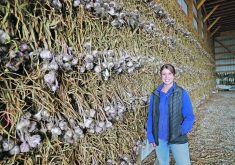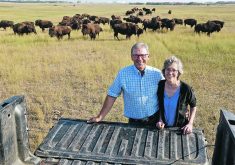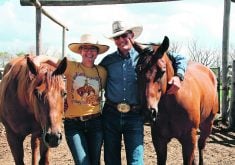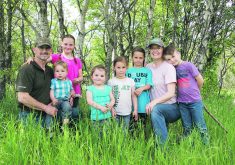On the Farm: Aaron Gray operates an irrigated grain farm and a 200-head cattle operation that are 350 kilometres apart
LANGENBURG, Sask. — It’s a good thing Aaron Gray’s commute between farms isn’t daily.
About 350 kilometres separate the 4,000-acre irrigation grain farm he and his brother operate near Brownlee, Sask., and the 200-cow cattle operation he and his wife operate at Langenburg, Sask.
In the eight years since Gray moved to the east-central area with Alecia and then-newborn baby Declan, he has established a schedule that makes it possible for him to be involved in both farms.
On a recent January day, he is watching a first-time mom and her newborn calf to make sure all is well. The calf is the 28th of the season so far and they are coming earlier than expected. The herd is young, with most less than five years old, and the plan is to build the purebred Simmental herd and downsize the commercial side.
More than 200 females are calving this year and the Grays are backgrounding 100 calves. More than 30 calves will be from purebred embryo transplants.
“We want to build up the purebred side and get better genetics for sires for our commercial herd,” Gray said.
This part of the province is well-suited to cattle production. The landscape of trees and sloughs offer shelter and water and Gray said he is transitioning their six quarters into growing feed.
He also intends to incorporate irrigation on this farm, which might raise a few local eyebrows.
Growing up in an irrigation area, Gray knows the benefits of applying water when it’s needed.
After he finished high school, he went to Australia for a year on an agricultural exchange program. That operation had 11,000 sheep, 300 cows and 3,500 acres of crop land.
When he returned in the mid-1990s, Gray became a journeyman agricultural mechanic and then studied truck and transport mechanics. He worked at Freightliner until 2004 when he became an instructor at what is now SaskPolytech college.
“It was great because I could teach November through April and farm from April to November,” he said.
He and his brother, Wade, also established a custom spraying business and Aaron transitioned to full-time farming.
When he and Alecia bought a farm that had been in her family they moved a shop, built corrals and started Aldaron Farms Land and Cattle.
Now Aaron is on the east side of the province for calving and haying and in the southwest, at A and W Grain Farms, for seeding and harvest.
He farms in a region where drainage has been a hot topic for decades. As the chair of the Saskatchewan Irrigation Projects Association, he looks at water differently than just trying to move it along.
On the Langenburg farm a 35-acre slough offers possibilities. Even with no runoff the last two years there was enough water in the wetland to irrigate for a season.
“I don’t want 12 inches of water,” Gray said, referring to the typical water allocation for a crop irrigator. “But just to supplement four to five inches throughout the growing season.”
This would be beneficial for alfalfa and corn crops to feed the cattle, he said.
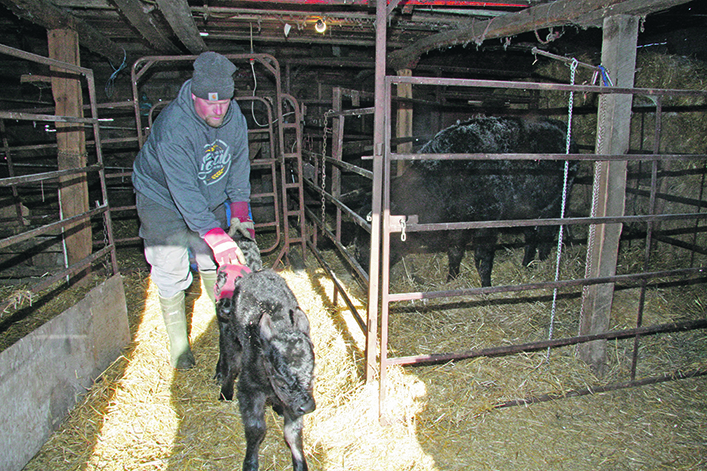
This slough, along with 25 acres on another piece of land nearby, are part of a demonstration project with the Water Security Agency to see how irrigating out of existing water bodies could make room for other water coming downstream.
“In 2014, there was no stopping the water because there were no checks and balances,” he said, referring to a flood year when uncontrolled drainage raised a lot of concern.
By retaining some water in his sloughs, he will mitigate drainage, be able to use the water from two different pump areas and pivots and improve his forage yields.
“It works for me and this property,” Gray said. “It will mitigate downstream drainage into Deerhorn Creek.
“The idea is to keep the reservoir at 50 percent capacity or less. Then if we get six inches of rain it will (go) into the reservoir, not downstream.”
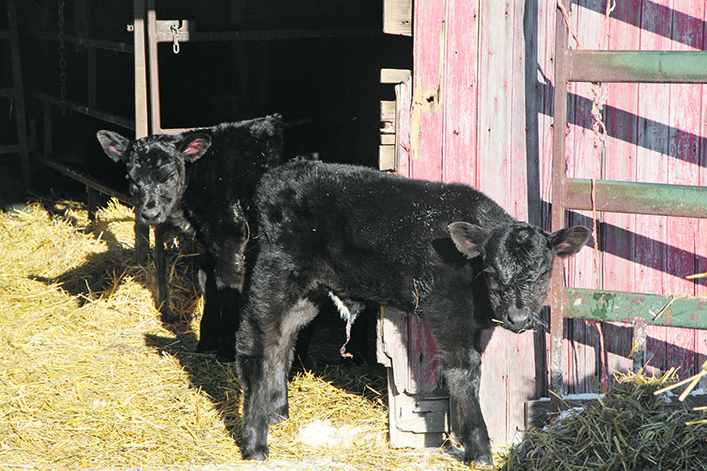
Gray said it may take a couple of years to figure out how it will work, but he said a full reservoir in spring should mean he could apply water as needed and get two or three good cuts of alfalfa.
Plus, there are the environmental benefits of more trees, habitat and better carbon sequestration. He works with Ducks Unlimited and ALUS and said they complement a cattle operation well. Even at the Brownlee farm, he and his brother worked with DU on a winter wheat project.
Gray also said he may not have as many farmable acres as farmers who have removed all their water bodies but he believes the land value will be higher because it will produce more yield.
“For a cattle operation, having irrigation is like a forage guarantee,” he said.
His cattle spend the summer at nearby community pastures. The Grays will be feeding cattle at home until then. They have also corn grazed and swath grazed to get nutrients on the land. Alecia will handle much of the spring feeding when Aaron once again heads west to the grain farm.






